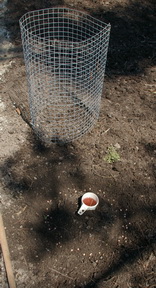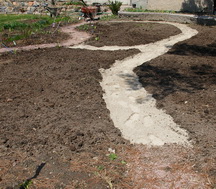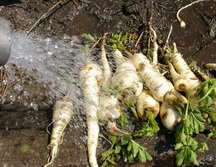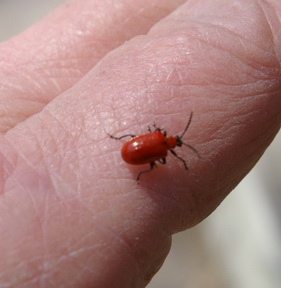

|
Now I know that we gardeners are obsessed by the weather but it has been doing strange things this year.  A couple of issues of “Dallying” ago I wondered about when to have my seed potatoes delivered because the snow was still piled up on the gardens. This week we have had several sunny days between 15 - 25C, (60 - 75F) and the garden has warmed and dried remarkably. If I had the potatoes I would have planted them. Yesterday I put in the early peas (picture right, wire frame goes over the pea seeds,) some Swiss Chard, Beets and Carrots. I transplanted the first of the onion seedlings and will get the new Violas into the front planters this afternoon. The bulbs are storming up out of the ground and are not going to stay in bloom very long if the temperature stays this warm.
A couple of issues of “Dallying” ago I wondered about when to have my seed potatoes delivered because the snow was still piled up on the gardens. This week we have had several sunny days between 15 - 25C, (60 - 75F) and the garden has warmed and dried remarkably. If I had the potatoes I would have planted them. Yesterday I put in the early peas (picture right, wire frame goes over the pea seeds,) some Swiss Chard, Beets and Carrots. I transplanted the first of the onion seedlings and will get the new Violas into the front planters this afternoon. The bulbs are storming up out of the ground and are not going to stay in bloom very long if the temperature stays this warm.  I worked on continuing the paths that wander through the garden. I started these last summer and didn’t want to dig up the potatoes to finish the job. It’s all part of making the back yard a Wonderful Wander and dividing the former large vegetable garden into smaller more accessible areas. I will continue to integrate the flowers and vegetables to make the whole Wonderful Wander more interesting.
I worked on continuing the paths that wander through the garden. I started these last summer and didn’t want to dig up the potatoes to finish the job. It’s all part of making the back yard a Wonderful Wander and dividing the former large vegetable garden into smaller more accessible areas. I will continue to integrate the flowers and vegetables to make the whole Wonderful Wander more interesting.  I should be planting some of the many early crop transplants to take advantage of this early spring but they are a bit small because I started them late to allow for the long heavy winter. I sometimes wonder if Mother Nature has a personal vendetta against me. I only try to make her look better with all of my efforts. Ate the first vegetables yesterday. Parsnips survive the winter in the ground and are rich and sweet, early in the spring. Just dig them up before they start new growth. Slice them in half lengthways, a little curry sauce on the cut side and then on to the grill until the interior is soft. Delicious! More delicious vegetable recipes here.
I should be planting some of the many early crop transplants to take advantage of this early spring but they are a bit small because I started them late to allow for the long heavy winter. I sometimes wonder if Mother Nature has a personal vendetta against me. I only try to make her look better with all of my efforts. Ate the first vegetables yesterday. Parsnips survive the winter in the ground and are rich and sweet, early in the spring. Just dig them up before they start new growth. Slice them in half lengthways, a little curry sauce on the cut side and then on to the grill until the interior is soft. Delicious! More delicious vegetable recipes here.  All of the warm weather has encouraged other things to get on with their spring rituals as well. The infamous Red Lily Bug adults are crawling out of the warm soil. They will find your emerging lilies fairly quickly but if you have any Fritillaria shooting up, these nasty beasties will devour them as appetizers as they wait for the lilies. Easy to spot if you are the slightest bit vigilant. Mine had already layed a few eggs before I got to them.
All of the warm weather has encouraged other things to get on with their spring rituals as well. The infamous Red Lily Bug adults are crawling out of the warm soil. They will find your emerging lilies fairly quickly but if you have any Fritillaria shooting up, these nasty beasties will devour them as appetizers as they wait for the lilies. Easy to spot if you are the slightest bit vigilant. Mine had already layed a few eggs before I got to them. The pond system is up and running and the fish are coming to the surface. Apparently they did not forget how to get fed during their long winter sleep. This warm weather without any shade cover on the ponds certainly speeds up the algae growth. The ponds went from cold and crystal clear to warm and cloudy in just a few days. The minute floating algae does get trapped in my home made filters but they are nowhere big enough or efficient enough to keep up with the growth at these temperatures. I need the water lilies to leaf out and also the shade tree over the ponds, to reduce the amount of sunlight that is feeding this rapid algae growth. The fish just can’t eat that much. Some very interesting responses to the last issue of “Dallying”. Several of you were kind enough to congratulate me on my new twin grandchildren. The interesting part was several said it would not be overkill to post pictures, they were all female and all the male responders just commented as they were asking a gardening question. Hmmm!
|
